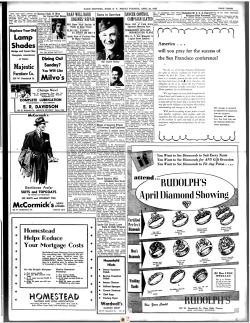
Document 250340
468 Canadian Journal ofHislOryIAnnalees canadiennes d'hisloire, Volume XLVI, Aulumnlaulomne and stimulating reflections on changing currents of thought in historiography and malariology, but lacking the strong argumentation and immediacy of the books by Packard and Shah. Lindsay Wilson Northern Arizona University Why America Is Not a New Rome, by Vaclav Smil. Boston, Massa chussetts, The MIT Press, 2010. xii, 226 pp. $24.95 US (cloth). Vaclav Smil is Distinguished Professor at the University of Manitoba and author of twenty-two books on energy, world development, population studies, and ecol ogy. Having had a life-long interest in Roman history, Smil critically addresses in Why America Is Not a New Rome whether or not comparative historical analysis of the Roman Empire and the United States sheds light on the future course of America in a global context. He wrote this work as a "corrective" to "misleading parallels" drawn between the two societies (p. xi). Smil focused on foundational issues: the exact meaning of empire; the real nature and scope of Roman and Amer ican power; what role "knowledge and innovation" as well as "machines and en ergy sources" played in the- two societies; Roman and American "demographic and economic realities" such as mortality, morbidity rates, poverty, and wealth (p. xi). His central thesis was that the above fields of inquiry revealed "specific and fundamental differences" between the two states (p. 148). Analogies between the two powers, Smil contended, rested upon the belief that Rome at one time con trolled much of the world, and upon the dubious assertion that the United States enjoyed global supremacy. He pointed out that the US was not an imperial power because it had never permanently occupied or exercised political control over ter ritories or states. Since both claims were false, there were no parallels between the two societies in terms of external power or world domination. Comparative meth ods have garnered much intellectual attention, Smil acknowledged, but in the case of imperial Rome and the United States, they were groundless, false, and anachro nistic. As a counterpoint to the notion of absolute American supremacy, Smil noted that economic growth in the 1990s, bolstered by "organizational ingenuity" (p. 22), technology, and a culture of achievement seemingly reaffirmed America's post-World War II imperial status. However, subsequent financial chaos, trade deficits, and extensive government corruption, in addition to unsuccessful wars on drugs and terrorism, cast shadows on unqualified faith in American might and imperalism. Although many analysts remained convinced that the ultimate eclipse of the United States from its supposedly lofty status will be a variation of Rome's downward spiral, Smil rejected this paradigm as defective because it rests upon anti-American bias, ignorance of Roman history and glib but uninformed "Roman Canadian Journal qlHistory/Annalees canadiennes d 'histoire, Volume XLVI, AUlumn/aulomne 469 ~" American analogies." These factors have contributed to a "misleading comparative edifice" that incorrectly posited the United States as a "new Rome" (p. 29). As an example of poorly chosen comparisons, Smil contrasts the conditions of the population of Rome, a city which he describes as filthy, squalid, and noisy, with contemporary American lifestyles. Based on median incomes, levels of con sumption, distribution of wealth and housing, Smil finds the "same degree of dis parity" as in other comparisons between Rome and America in terms of "energy use ... infant mortality, or common morbidity" (p. 146). Smil contrasts the misery of an average Roman with the unprecedented affluence of modem Americans. Chapter three is the most convincing part of the book because of Smil's in comparable knowledge of energy and "biophysical fundamentals" (p. 63). He points out that all cities or civilizations were highly organized energy conversion systems which made up the physical foundation ofa society's success. "[E]nergy use - its pattern, level, and efficiency" was, Smil argues, the "single most impor tant factor that explains the differences between standards of living and the overall power of states" (p. 105). Readily available, dense sources of energy and its effi cient transformation into goods and services in America made ideals such as a con stitutional political order and continental sovereignty a reality. Rome's limited capacity to access dense sources of energy and to translate this energy into useful work put its energetics many levels below this same process in modem America. This, Smil concluded, made the United States and Rome "fundamentally incom parable" (p. 105). How would scholars respond to Smil's criticisms? They might complain that they did not view the US as an empire; instead, it was a hegemonic world power that was "first among equals" (p. 53). Smil accepts this qualification, but warns that the US has been a leader rather than ruler or commander of other states. He maintains that the post-World War II US was consistently unable to get nations, including its allies, to follow its lead. Even if America has exercised hegemonic leadership, it has been "met with a great deal of doubt, dissent, and rejection" (p. 64). Further, he thinks that American power and influence, whether territorial, po litical or military, has been "vastly exaggerated[,]" and was "less effective and .. . more fragile" than many perceived it to be (p. 158). With this in mind Smil ad vises historians to abandon baseless analogies and flawed definitions of empire, and instead to contrast the demise or implosion of the western half of the Roman Empire with the events that supposedly will lead to the anticipated comedown of the US. Smil is confident that they will find a downward trajectory in American power and influence'that got underway after World War II, but requires no mis leading analogies with the Roman Empire to understand. This book is interesting for several reasons. First, Smil fearlessly tackles the issue ofwhich comparative methodologies are historically sound. This is important because all historical judgments or observations make sense only if they rest on comparisons. IfF.D.R. was a great president, it could only be the case if one had in mind less stellar holders of that office. Second, as someone interested in risk, hazards, and disasters, and their intersections with energy sources, carriers, and 470 Canadian JOI~rnal ojHistorylAnnaiees canadiennes d'histoire, Volume XLVI, AUlumnlautomne markets, I found compelling and undeniable Smil's observation that energy avail ability, densities, and efficient transformation into useful work are the components that "circumscribe the economic, military and ... social capacities of any society" (p. 79). Third, Smil's integration of energetics into historical analysis is a wel comed interdisciplinary technique from which comparative history will benefit. James B. McSwain Tuskegee University War in an Age ofRevolution, 1775-1815, edited by Roger Chickering and Stig Forster. Publications of the Gennan Historical Institute. New York, Cambridge University Press, 2010. xii, 422 pp. $80.00 US (cloth). An excellent historiographic review on the "military revolution" of the early mod em era, what it was and what its critics assert it was not, opens this collection. The two master narratives, one asserting a revolutionary break due to tactical innova tions, the other emphasizing mass warfare emerging from political upheaval, are clearly outlined. The editors :- known for an exceptional series of studies explor ing nineteenth and twentieth century warfare and its societal meaning - suggest that the greatest changes were yet to come: " ... to call this phenomenon total war in the age of revolutionary war is ... to indulge in hyperbole. But family resem blances were at least recognizable"(p. 17). The twenty chapters in this well-crafted volume are by noted historians. Though a few essays speak to the evidence of the early modem era, most address the revolutionary era itself in Europe and the Americas. Some authors venture into the colonies to show the beginnings of global warfare with one suggesting that perhaps the Seven Years' War nearly involved the whole world. A detailed analysis by Azar Gat astutely marshals wide-ranging evidence to conclude "the so-called military revolution that was to give Europe global ascendancy emanated neither from muskets and drill nor from artillery fortifications - nor, indeed, from any other tactical development in itself. Rather, the revolution was one element ofEu rope's general, centuries-long process of modernization ... " (p. 48). The reserva tions of Gat's conclusion are echoed in many of the contributions. Here only the contents of the three-part book will be described and a few of its findings high lighted. Part I offers "Perspectives on a Military History of the Revolutionary Era." It includes essays by Gat asking what constituted the military revolution; by Beatrice Heuser showing Count de Guibert not being a prophet of total war; by Ute Planert observing more evolution than innovation in the French wars; by Dierk Walter showing the limits of the Prussian reforms; by Stig Forster finding the first world war during the Napoleonic era due to European, especially British, expansionism; and by Gunther Kronenbitter examining Friedrich Gentz's military lessons. Part
© Copyright 2025












